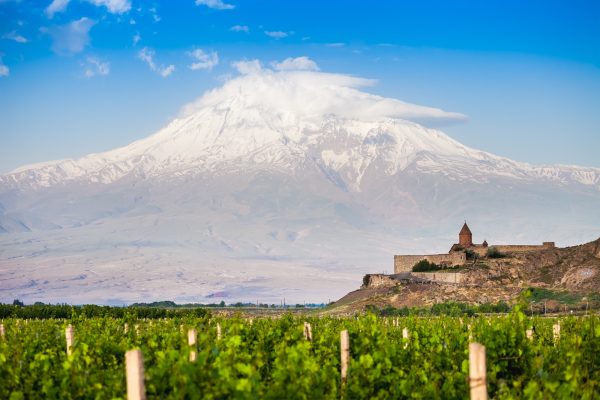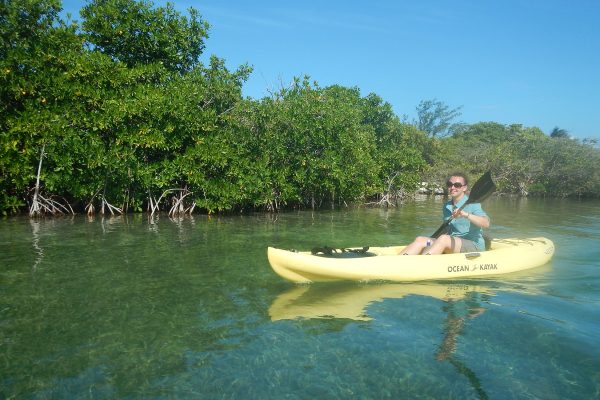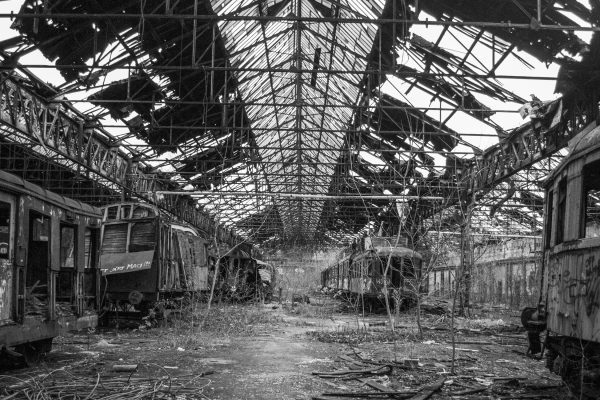Trip duration: 4 days | Approx cost: £400 | When: May – Sep
Doinit factor: Visit two beautiful cites in one trip!
Never having been to Portugal I thought a swift city break to either Lisbon or Porto would be exactly what the doctor ordered. Having heard good stories about both, I found it rather hard to decide which to choose… so I chose both.
With the travelling distance between Portugal’s two largest cities being a little under three hours by train, it’s relatively easy to incorporate both into a double city break, flying into one and back home from the other. We’ve pre-booked our train tickets on the high speed Alfa Pandular tilting trains for a bargain of 18 Euros which will take us speedily from city centre to city centre.
Lisbon
Our trip starts in Lisbon and with our late afternoon arrival there’s not much time to relax or put our feet up. It’s late October and I am conscious there’s only a few hours of sunlight left. We’ve based ourselves in Lisbon’s Alfama district, the city’s oldest. Settled on a gradual hill, a maze of picturesque alleyways, stairways and courtyards separate the beautifully tiled buildings that have stood here for hundreds of years with not a single level surface in sight.
Ten minutes uphill we visit São Jorge Castle which overlooks Alfama and much of Lisbon; It’s a perfect spot to watch the sunset over the capital. The views stretch to the other bank of the wide Tagus River where in the distance you can see a 25 metre tall statue of ‘Christ the King’. The silhouette of the Ponte 25 de Abril Bridge – which very much resembles the Golden Gate in San Francisco – is impressive and below us the city centre with its terracotta roof tiles and colourful building facades makes for a fantastic first impression of Lisbon. Once the sun disappears below the horizon we continue our dusk walk along the 16th Century castle fortifications.
Our walk back from the castle takes us past the city’s cathedral, a beautiful building which has been renovated numerous times since its construction in 1147 now incorporating the different architectural styles. Being a layman would simply describe it as rather gothic. Lisbon’s famous vintage trams ring their bells as they wiz past and I try to get the picture post card shot, I fail.
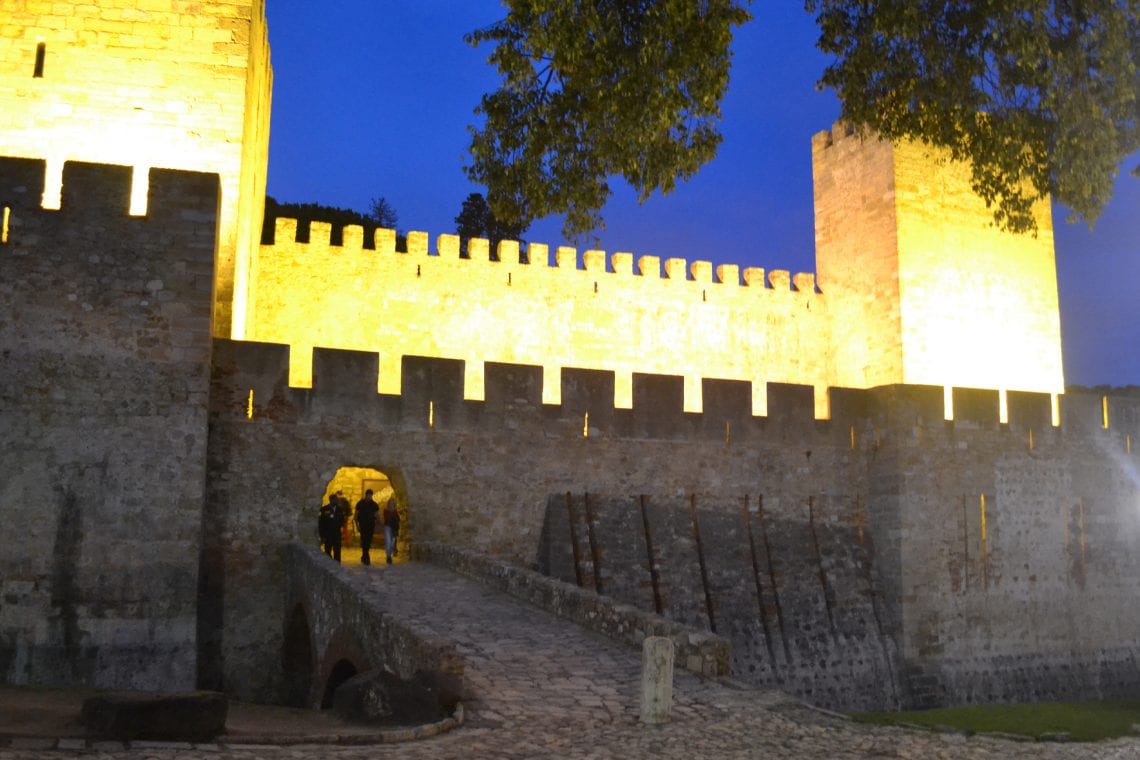

Above: Strolling through São Jorge Castle which overlooks Alfama and much of Lisbon
Satisfied we’ve had a pretty good start at exploring Lisbon, in a few hours it is time for dinner. Alfama is famous for its small cosy restaurants featuring musicians playing the city’s famous Fado music. It traces its roots back to the 1820s and features singers and the Portuguese guitar. You can hear the voices of different singers resonate through alleyways as tourists dine in these quiet little establishments. For us, that’s exactly what we intend to do too and it’s not long before we’re seated and listening to our waitresses sing their ballads.
Over dinner an elderly English gentleman comes over. He explains he’s been studying Fado for some years and that what we’re hearing and generally in most of the establishments is not true Fado, “it’s been through the washing machine a few times for the tourists”. True Fado comes at a higher price, but to us it’s good enough as we dine and finish the evening up with a bottle of Portuguese red wine.
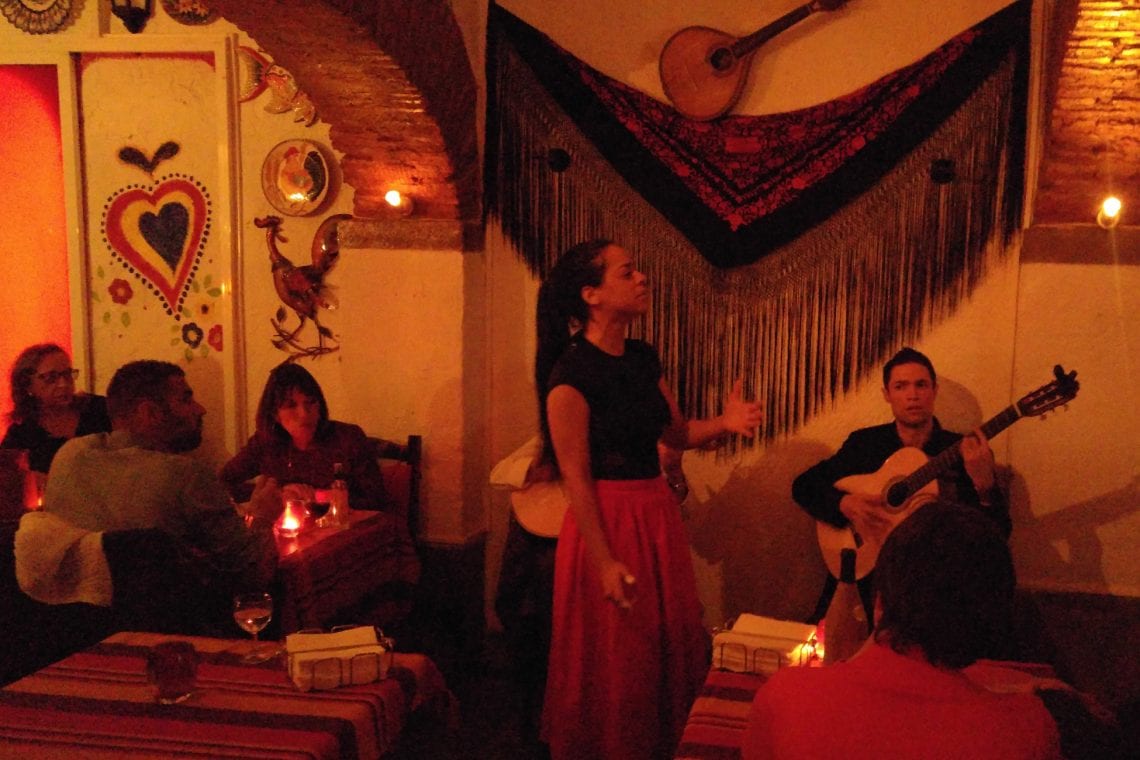
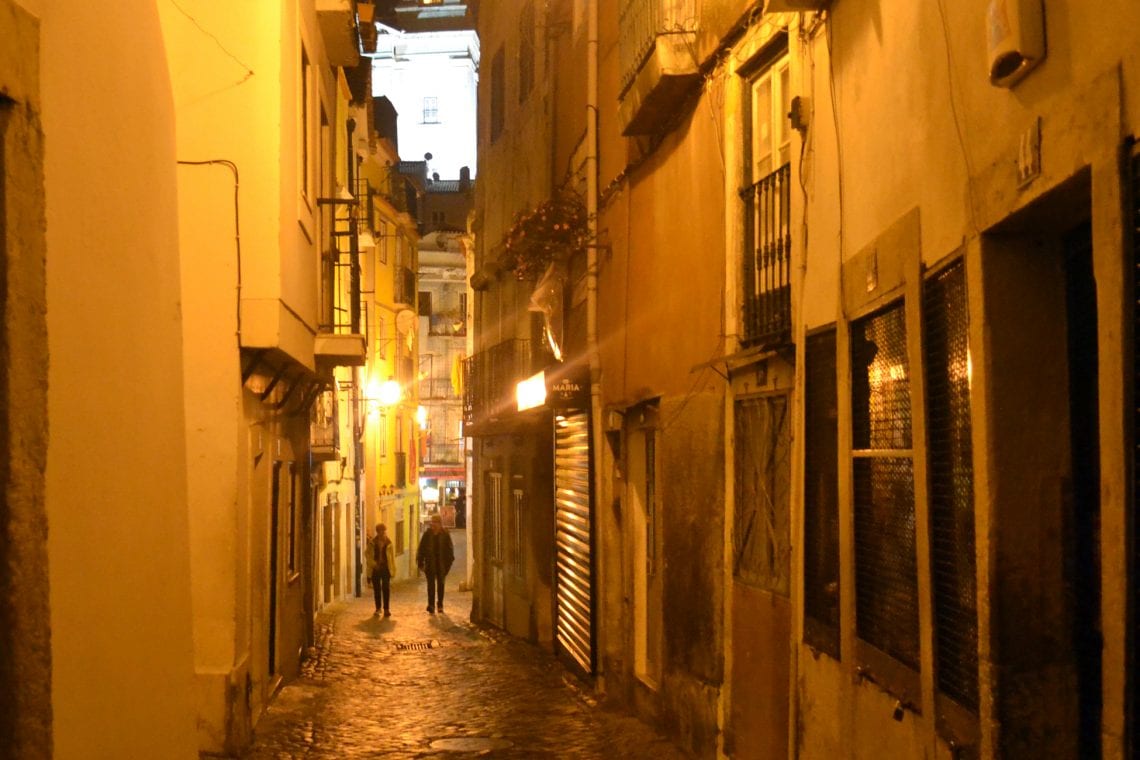
Above: The Patriarchal Cathedral of St. Mary Major or simply Lisbon Cathedral, with tram 28 | Dinner and Fado in Alfama
Day two sees us visit the Belém area about 30 minutes away by bus or tram. It is located close to the river mouth and is well known for its concentration of historic buildings and monuments. One could easily spend all day here but we’re on a tight schedule so we head straight for the highlight. We pass the Jeronimos Monastery – a beautiful building with tranquil gardens and fountains – on route to the Belem Tower which has stood guard at the mouth of the river; protecting the area from pirates and enemy attack since 1519. An important symbol for the city – the first and last sight of home for sailors making their voyages of discovery. A short walk down river is the Monument to the Discoveries; It’s essentially a massive slab of concrete put up in 1960 in the shape of the front of a ship and features prominent figures from Portugal’s age of discovery.
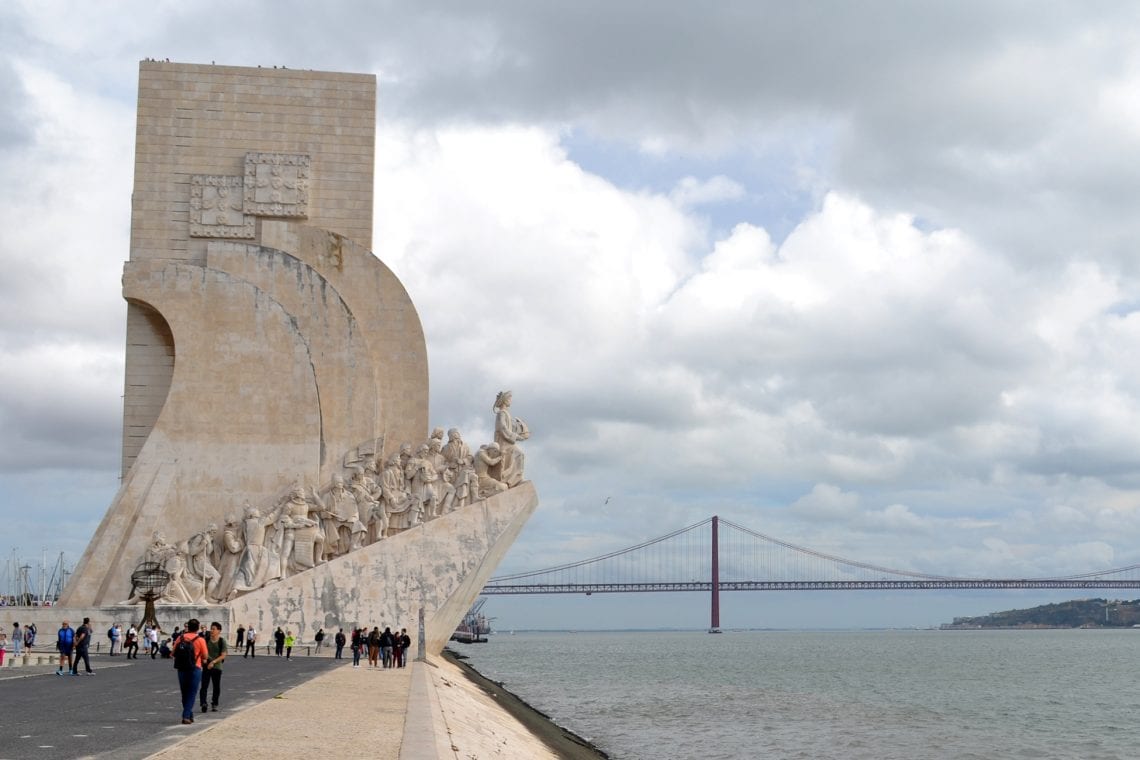

Above: Belem Tower standing guard at the mouth of the river | The Monument to the Discoveriers
We take the tram back towards the city centre hoping for a chance to ride one of the popular Funicular’s, Bica; but it’s broken. We’re forced to walk up the very steep street, however, we are rewarded by the little secluded green space where we can rest with views over parts of the city. Once we’ve caught our breath, we do what every visitor in Lisbon must do, what every guidebook says you have to do – ride the iconic number 28 tram. These vintage trams take in most of the areas of interest and they get rammed. It’s like being back home on a commuter train and it is a quick realisation that the idea of riding these trams is a lot different to actually being on one. Nevertheless, it is an experience as the tram abruptly stops, starts and changes direction; you really do have to hold on. Gradually the people begin to filter out and we can get a seat as we take the tram to the Garcia district where we are told there is a lovely view of the city at the Miradouro da Senhora do Monte. There we sip on our espresso in solitude admiring another amazing view of the city.

Above: The Bica Funicular
During early evening it’s a walk to and through Rossio Square (Lisbon’s equivalent of London’s Trafalgar Square) as we stroll to the lively downtown district of Baxi. This area was rebuilt after a large earthquake in 1755 resulting in a different feel to the other parts of the city. For a start, the streets are straight and parallel here unlike much of the rest of the city. There are large crowds and pedestrians walking back and forth past the trendy shops and restaurants. This is modern(ish) Lisbon, but still very pretty. Located here is also the famous Santa Justa Elevator. Completed in 1902 it was designed to help facilitate movement between downtown Lisbon and the much higher Carmo Square. It will be sunset soon but instead of joining the long queue for the elevator ride, we opt for the short walk towards Lisbon’s Triumph Arch. With no queues, it is here we enjoy a fantastic sunset atop of the arch and it feels like you have Lisbon all to yourself.
The arch overlooks the large Praça da Figueira (Square of the Fig Tree), the river Tagus, Baixa and Alforma making it possibly the ‘best place to enjoy a sunset’ in the city – or at least that’s what the posters say. With a lot of walking done today, my calves feel the strain and we sit and watch the sun for the best part of an hour before we decide to head back to Alfarma but before we do, and back on street level, our attention draws us into Lisbon’s Beer Museum. Rationalising that it would be rude not to, we step in for a pint of their own local craft brew, which can come accompanied by fresh fish and sheep cheese balls made right in front of the customer, yum. Once again the day is finished with dinner, Fado and wine in the Alfama district.
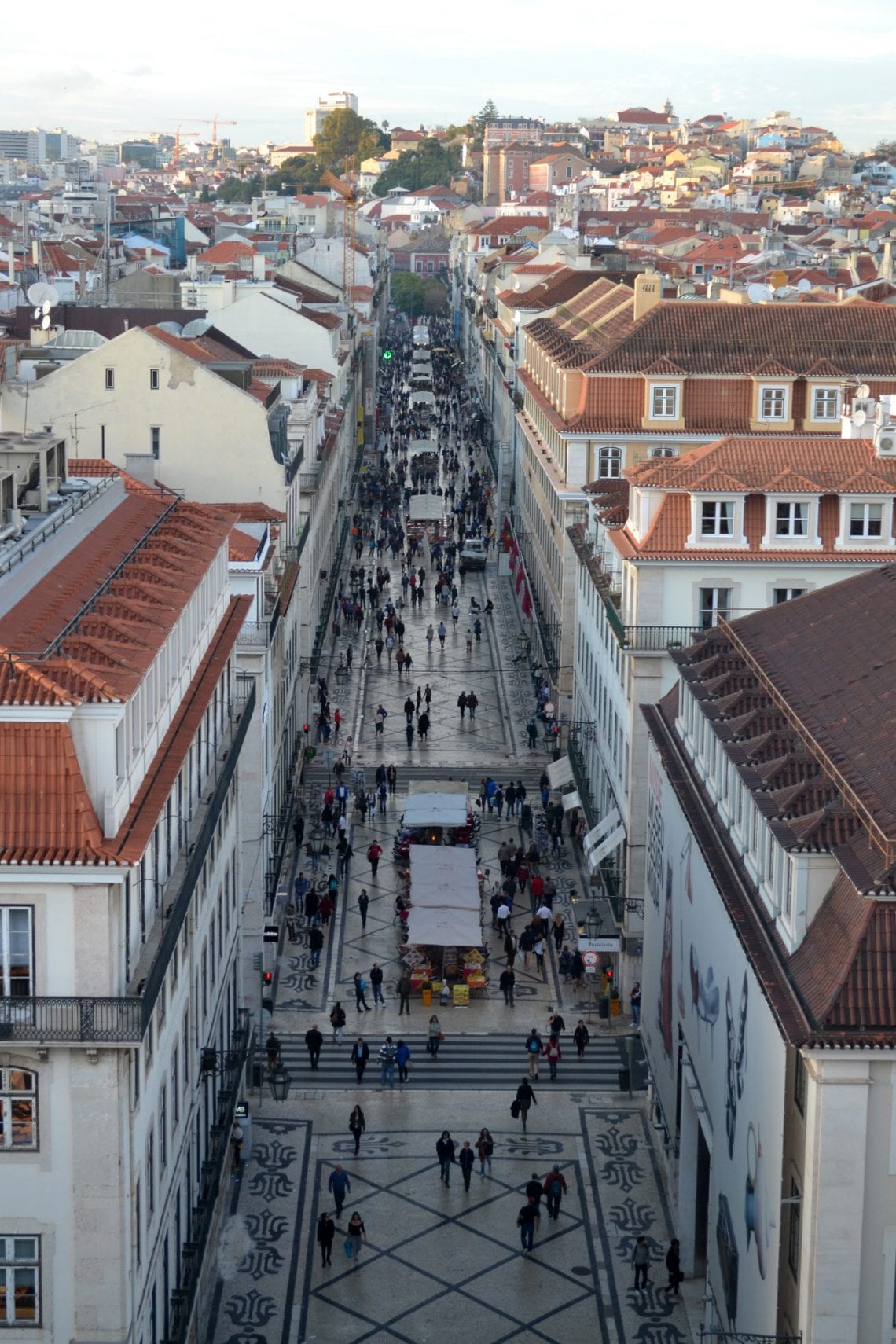
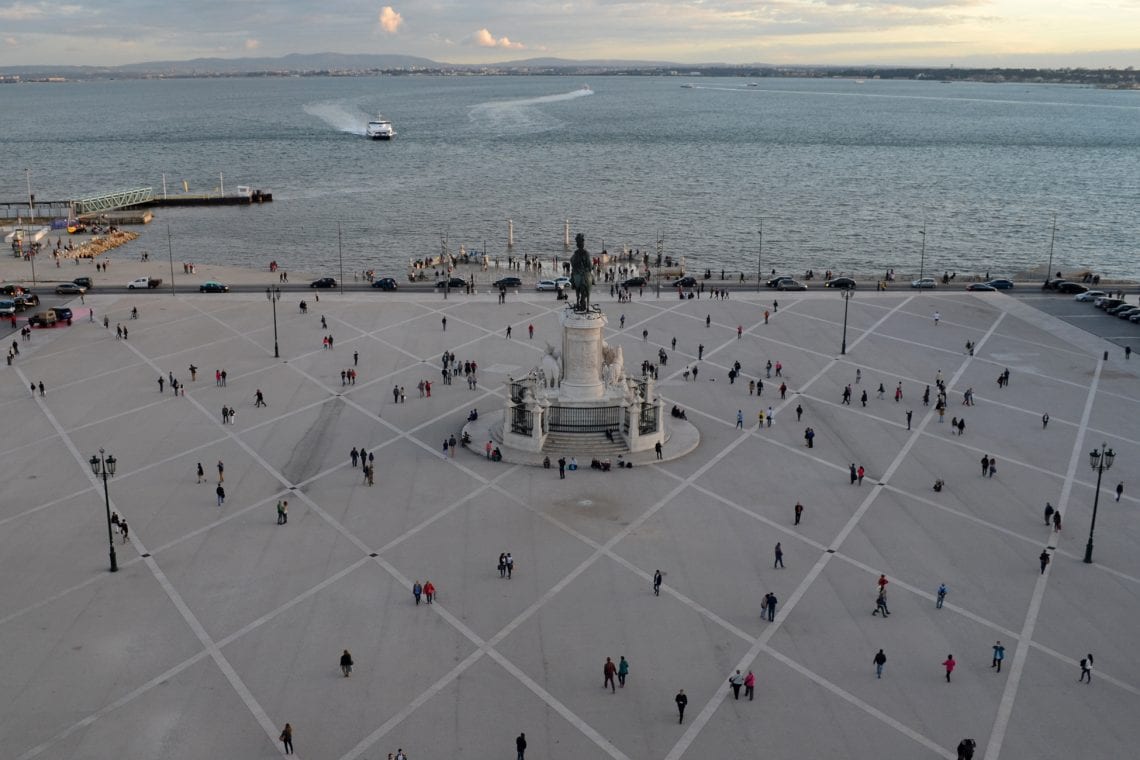
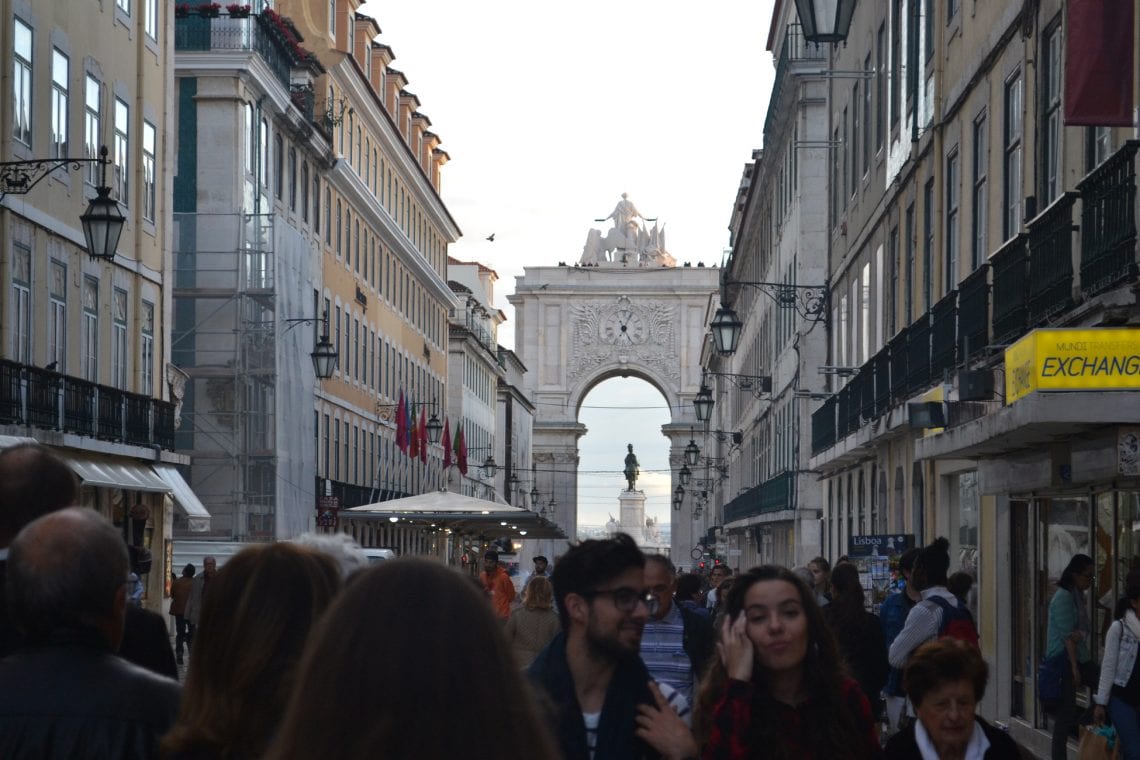
Above: Lisbon’s Square of the Fig Tree | Views from atop of the Lisbon’s Arc de Triomphe – Rua Augusta Arch | Enjoying a freshly crafted beer and fish cakes at the brewery
Porto
On our third day it’s time to leave wonderful Lisbon and get our train to Portugal’s second city, Porto. The journey is effortless and by 2.44pm we’re pulling in to Porto. Again we locate ourselves centrally. We have very little time in Porto, just a little over 24 hours as we’re due to fly back the next day so it’s a case of dumping our stuff and heading out.
It’s time for a very late lunch. We’ve learnt that Porto is home to a remarkable local speciality, a type of sandwich called the Francesinha which means little Frenchie; It’s Porto’s answer to a Croque Madame. This sandwich has layered steak, ham, chorizo sausage, covered in cheese and an egg all topped off with a spicy beer sauce. Admittedly it doesn’t look great served up, but cut it in half to expose the meats and you’ll be in culinary heaven. By chance Santiago’s Café which is reputedly one of the best places to get one of these beasts is a few minutes’ walk away so it’s a given that’s our first stop in Porto.
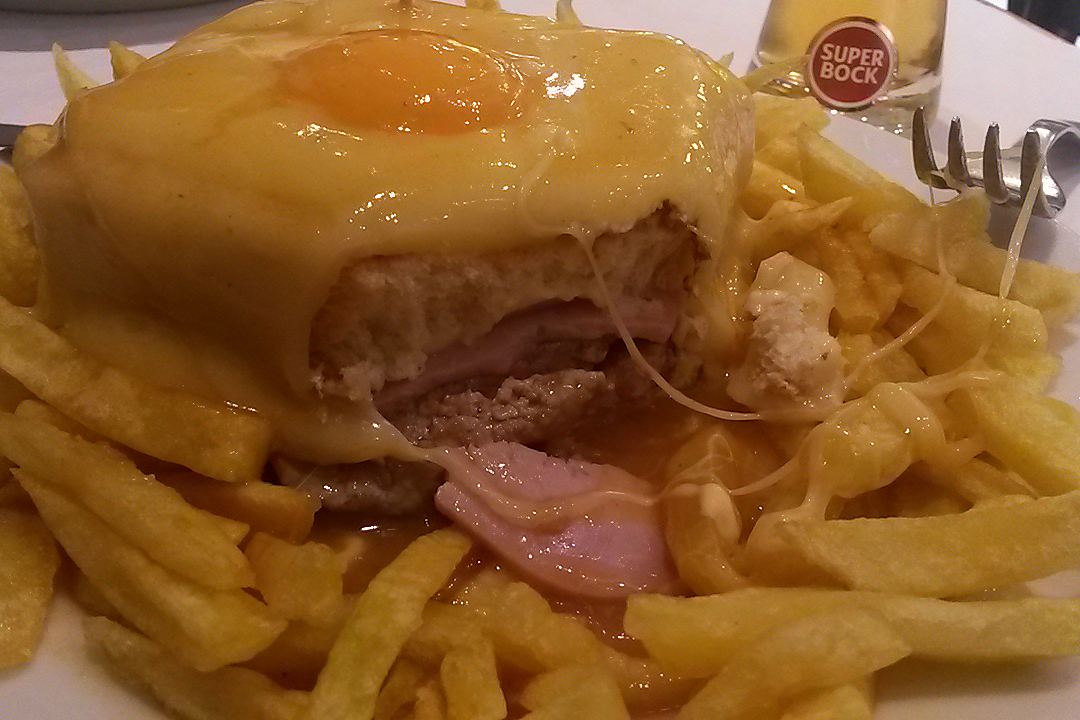
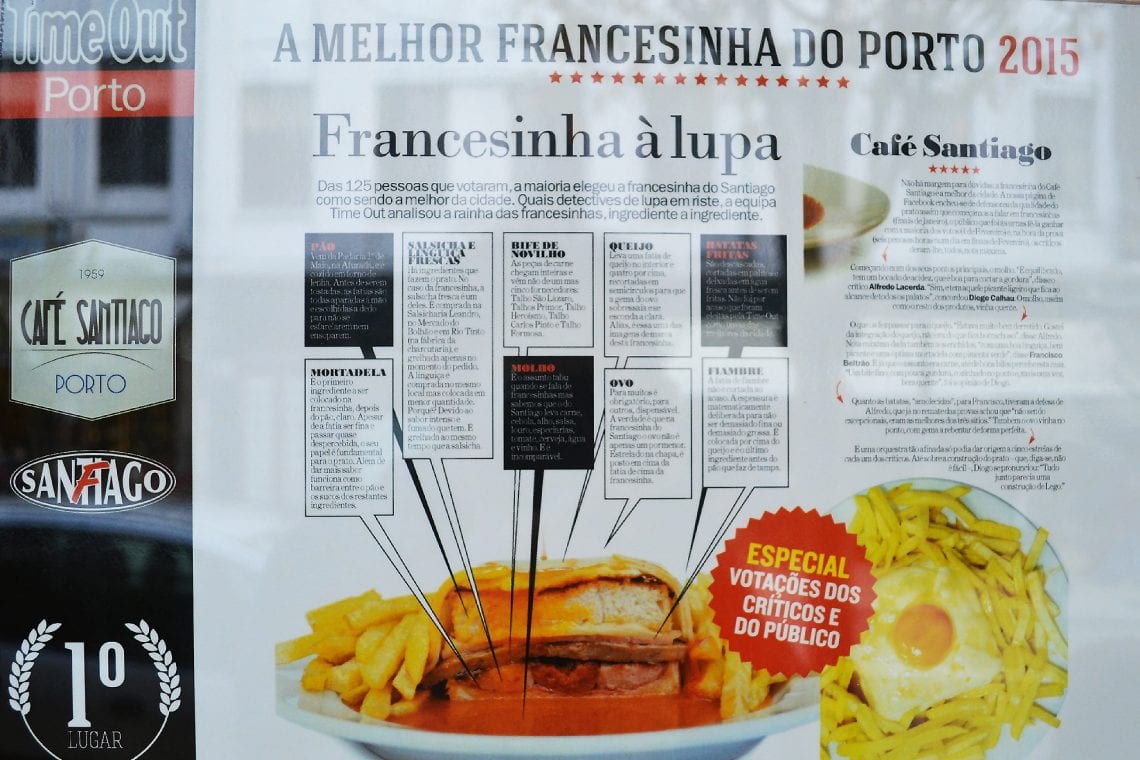
Above: Porto is full of beautiful architecture like the Church of Saint Ildefonso | Francesinha sandwich at Santiago’s Café
After devouring what is most likely a heart attack on plate, it’s a short walk past Praça Liberdade square in search of the Clérigos Church (Church of the Baroqu) and its tower. At a height of 75.6 metres it dominates the sky line, if your view isn’t blocked by tall buildings running along narrow streets. Our visit to the tower incurs a rather annoying 45 minute queue to reach the top, which is hidden so you can’t tell how long it is from the outside (to be fair we were given warning as we paid our admission). Sadly, we’ve missed sunset but we do complete the 240 steps to reach the top to see Porto lit up below us with many of the city’s buildings lit up in the distance.
A couple of minutes away is Porto’s famous book shop, Livraria Lello. It is one Portugal’s oldest book shops and its staircase is said to have inspired the staircase in the Harry Potter books. We have to buy an admissions ticket and queue for a couple of minutes before we are allowed in, at first it is a bit off putting to have to pay to enter a shop, but just before we enter we are told that the admission fee will be discounted off of any purchase we make. With 3 Euros each that gives us 6 Euros and sets off a new game – the aim to see if you can actually buy something between us for under 6 Euros and therefore making it free, well kind of. It’s not easy, Porto’s premium book shops won’t be a bargain basement store but truth be told the prices are not too high. We find a small Portuguese recipe book written in English for 6.50. That’s good enough and we present our two admission tickets at the counter with a 50 cent piece and complete our purchase.
The book shop itself is justifiably busy. It’s wonderfully decorated, antique and quant, filled from floor to ceiling with books. At its centre is a stair case which must have surely been crafted by a carpentry master, the stair case splits and winds back on itself to form a bridge between the opposite sides of the open level opening up to the beautiful ceiling comprised of a lovely stain glass sky light. Whilst at the shop we are also treated to a dramatic reading of Edgar Allan Poe to coinside with Halloween
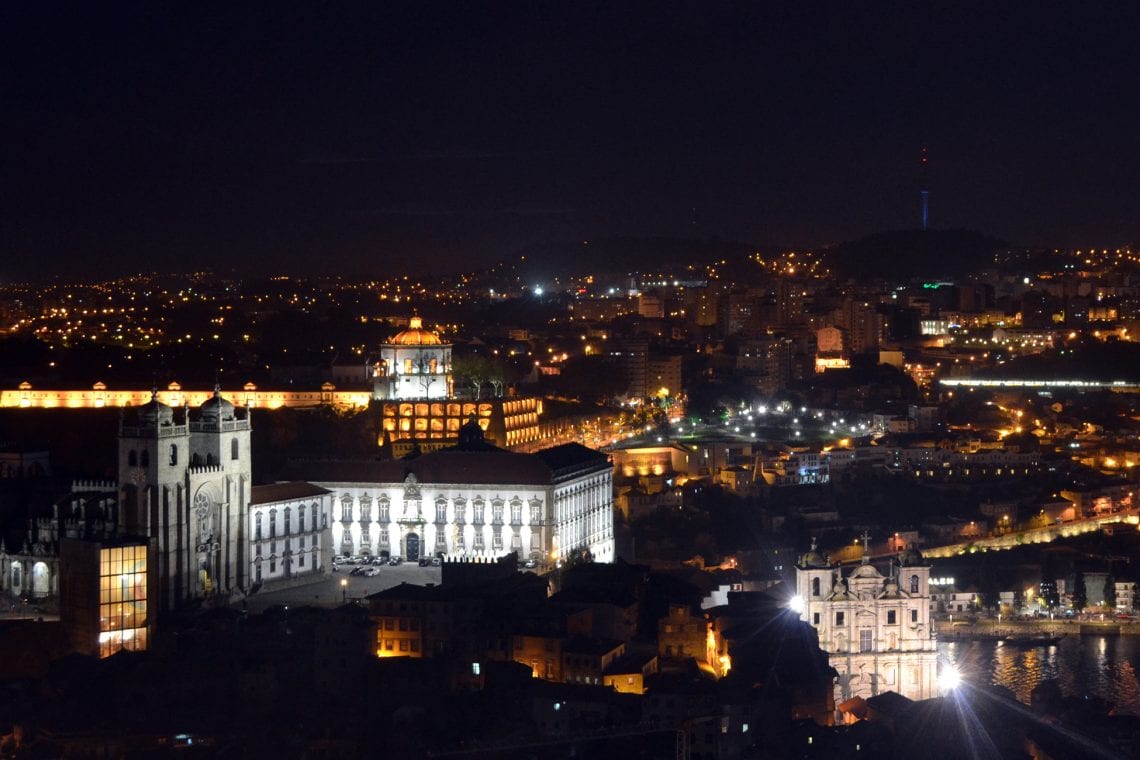
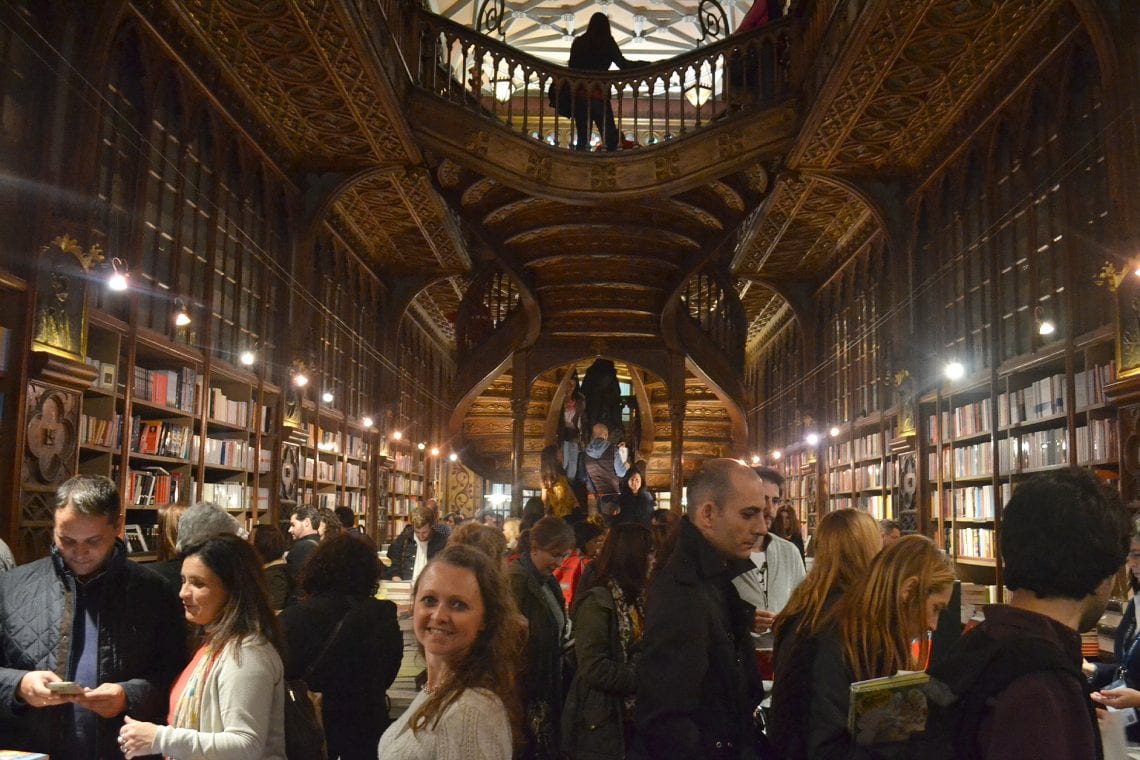
Above: The view from the tower of Clérigos Church (Church of the Baroqu) | Porto’s famous bookshop
Our final stop for the day is a walk to Ribeira, the riverside. Enroute we pass coutyards, beautifully decorated buildings, relaxed bars, niche shops and buskers. The main square at Ribeira is designated a UNESCO World Heritage site and provides for a lovely stroll along the bank of the river Douro. It’s an ideal place to grab some early evening tapas and a beer while being overlooked by Porto’s famous double decker bridge connecting the two sides of the valley. Street lights omitting tungsten light give the tall narrow buildings an orange glow and infront of us streaks of light reflect off the dark river. On the opposite side we can see illuminated signs of the Port house where we will be heading tomorrow before we reluctantly must fly home.
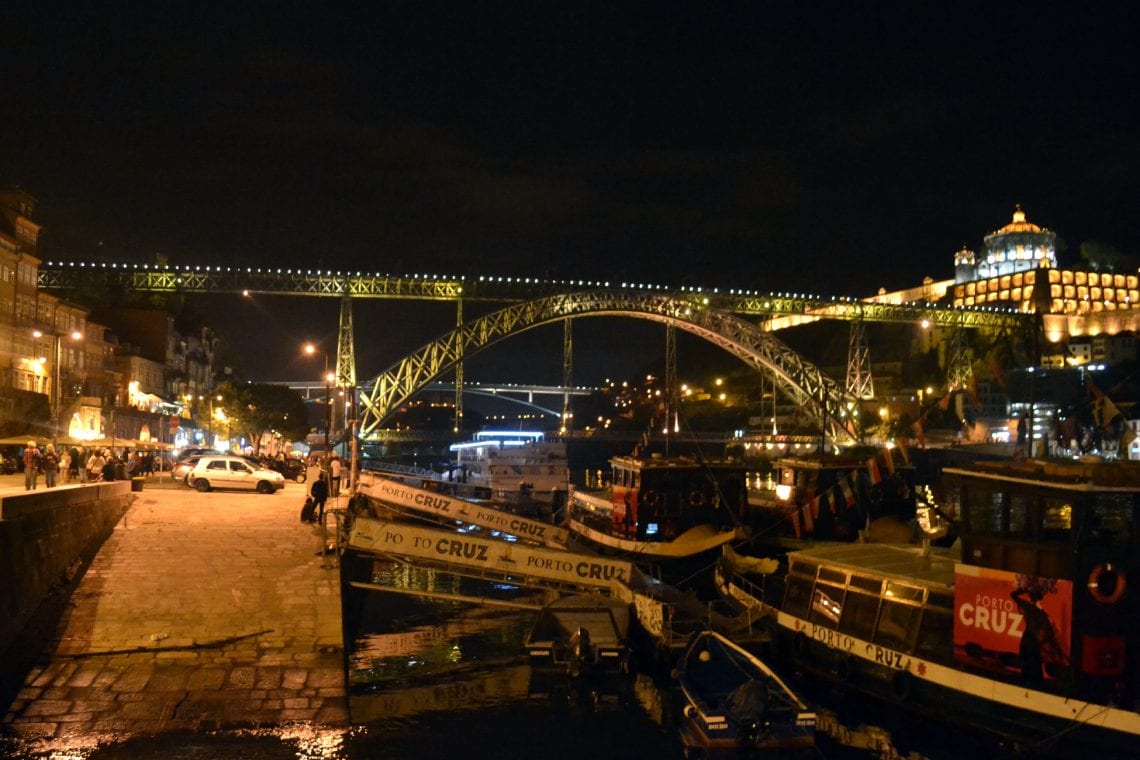
Above: Riberia is a wonderful place to take a night time walk
On our last day in Porto and Portugal we visit one of Porto’s best Port Houses. There are plenty to choose from but we’re given a tip that the Ferreira’s Port Cellar is the best so that’s where we head. As the port houses are on the north bank of the river, we walk across the top of Dom Luís I Bridge. The clear, sun filled sky and being so high above the valley, allows us to take in wonderful views of this colourful city, including Ribeira where we enjoyed our tapas last night. The walk over the bridge is defiantly a highlight which I would recommend to anyone but be careful of trams whizzing past. On the opposite shore we use a cable car to take us back down to river level.
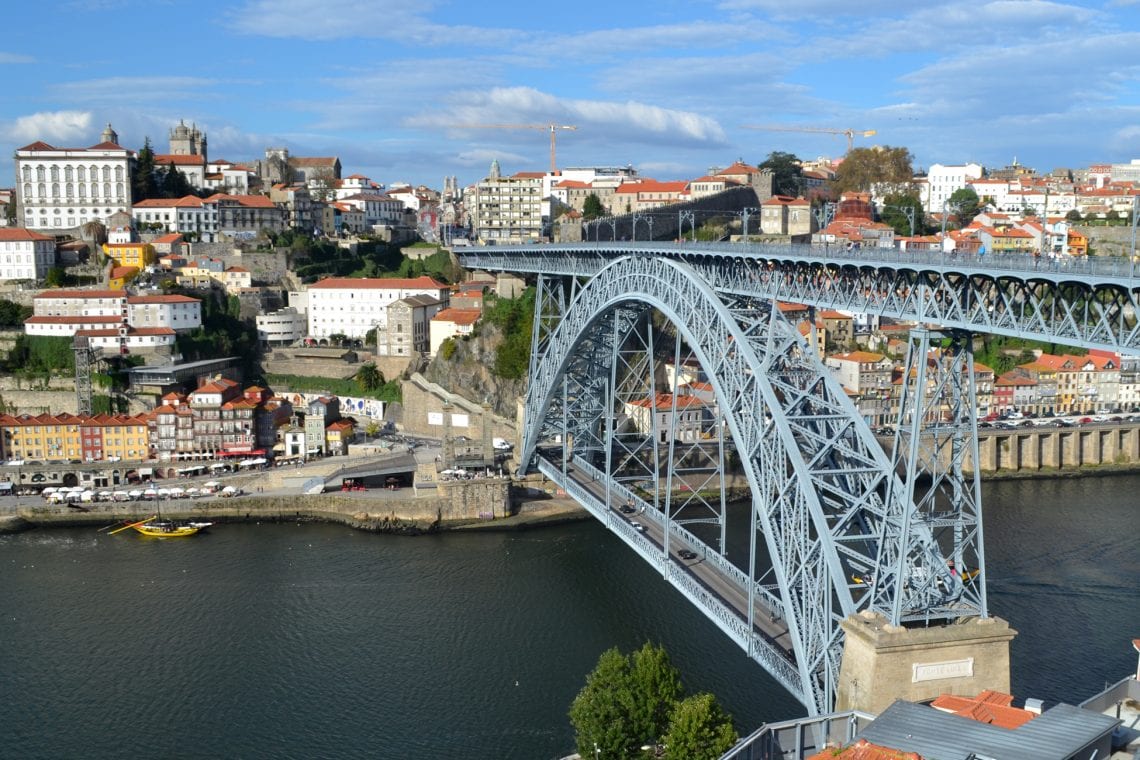
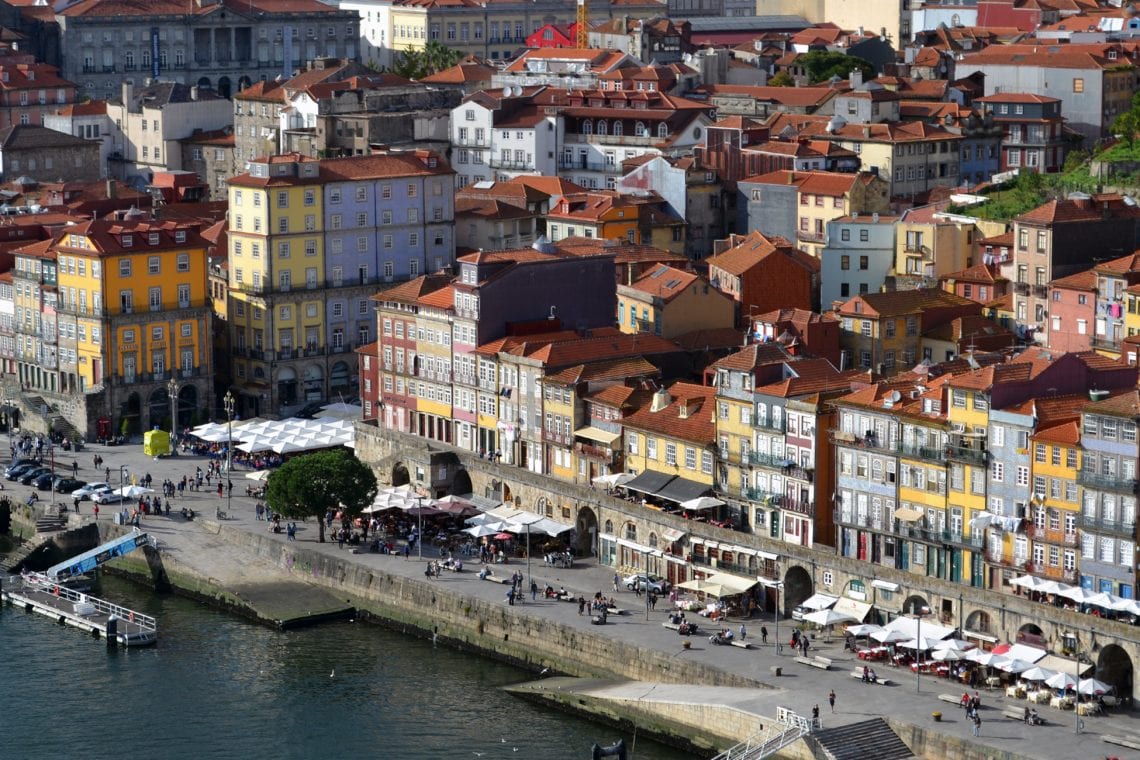
Above: Porto’s UNESCO World Heritage site with the Clérigos tower in the background | Dom Luís I Bridge
The Ferreira’s Port Cellar is much cooler than outside. It’s dark and there are barrels of port everywhere. We’re given a tour and a guide explains how the port is made in the Douro Valley and then how it is transported to these cellars where they are stored for the ageing process. It’s a 30 minute tour but it’s rather informative and we learn about different ports and how they are aged. I’m surprised to learn that white port is common here and new ports in a rosé form are being introduced, but when it comes to the tasting at the end of the tour, it’s the Ruby 10 year old late bottle vintage which I prefer. After 3 generous glasses of port we have just enough time for lunch consisting of salted cod (another Porto speciality) by the river before we force ourselves up and take the metro to the airport.

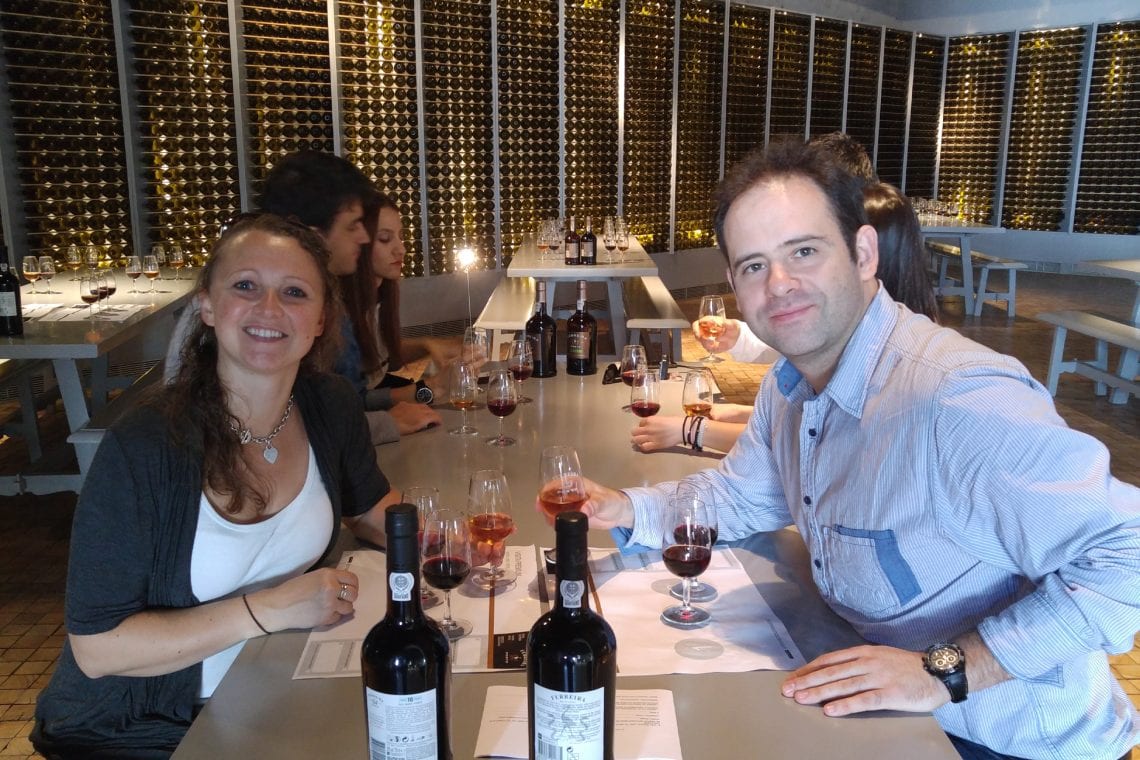
Above: Port tour and tasting at the Ferreira Port Cellar
Four days and two lovely cities make for a fantastic and exhausting visit to Portugal but I totally fell in love, first with Lisbon but then with Porto. I wish we had one more day, especially in Porto. While Lisbon is beautiful in its own right I can’t but help but be intoxicated (both figuratively and metaphorically) by Porto’s charm. Porto just seems more raw and real. It also feels like you are in Portugal whist Lisbon could be one of many beautiful southern coastal cities. Still, with the straight forward connection between the two cities I would strongly urge you not to pick Porto over Lisbon but to visit both.
WHERE TO STAY
A simple internet search will relieve ample options for accommodation. Like all cities you can find luxury as well as more modest accommodation.
USEFUL LINKS
- Train tickets: www.cp.pt
- Visit Lisbon
- Visit Porto and North
- Book a wine cellar tour with: Ferreira Cellar



